拍照搜题之后,猿辅导推出拍照批改英语作文功能-阿槑 (芥末堆)
ai 批英语作文
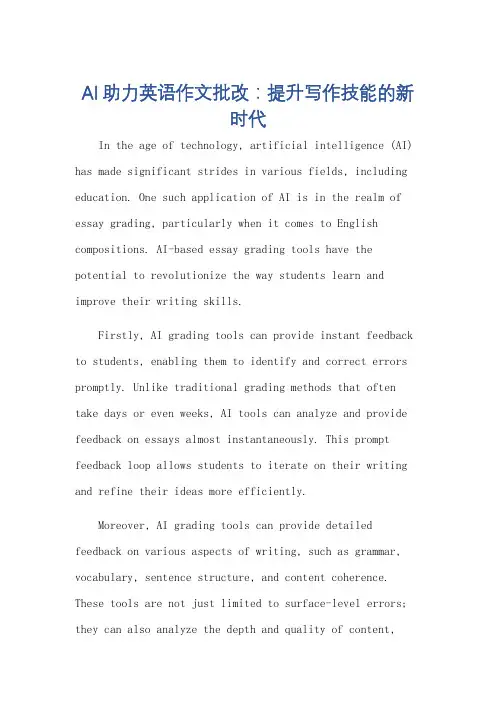
AI助力英语作文批改:提升写作技能的新时代In the age of technology, artificial intelligence (AI) has made significant strides in various fields, including education. One such application of AI is in the realm of essay grading, particularly when it comes to English compositions. AI-based essay grading tools have the potential to revolutionize the way students learn and improve their writing skills.Firstly, AI grading tools can provide instant feedback to students, enabling them to identify and correct errors promptly. Unlike traditional grading methods that often take days or even weeks, AI tools can analyze and provide feedback on essays almost instantaneously. This prompt feedback loop allows students to iterate on their writing and refine their ideas more efficiently.Moreover, AI grading tools can provide detailed feedback on various aspects of writing, such as grammar, vocabulary, sentence structure, and content coherence. These tools are not just limited to surface-level errors; they can also analyze the depth and quality of content,offering insights into areas where students can improve. This comprehensive feedback helps students to develop a more nuanced understanding of their writing strengths and weaknesses.Additionally, AI grading tools can adapt to the unique writing styles and preferences of individual students. By analyzing a student's past writing, these tools canidentify patterns and trends, allowing them to provide more personalized feedback. This personalization ensures that each student receives feedback that is tailored to their needs and helps them to develop their unique writing voice. However, it is important to note that while AI grading tools offer significant advantages, they should not completely replace human grading. Human graders still have the ability to understand and interpret the nuances of language and writing that AI tools may miss. Moreover, human graders can provide emotional support and encouragement that is crucial for students' motivation and engagement.In conclusion, AI-based essay grading tools hold great promise for enhancing students' writing skills. These toolsprovide instant, detailed, and personalized feedback, enabling students to improve their writing efficiency and quality. However, they should be used as complements to human grading rather than replacements. By leveraging the power of AI, we can usher in a new era of writing instruction that is more efficient, personalized, and engaging for students.**AI助力英语作文批改:提升学生写作技能的新时代** 在科技日新月异的时代,人工智能(AI)已在各个领域取得了显著进展,其中包括教育领域。
英语作文拍照纠错
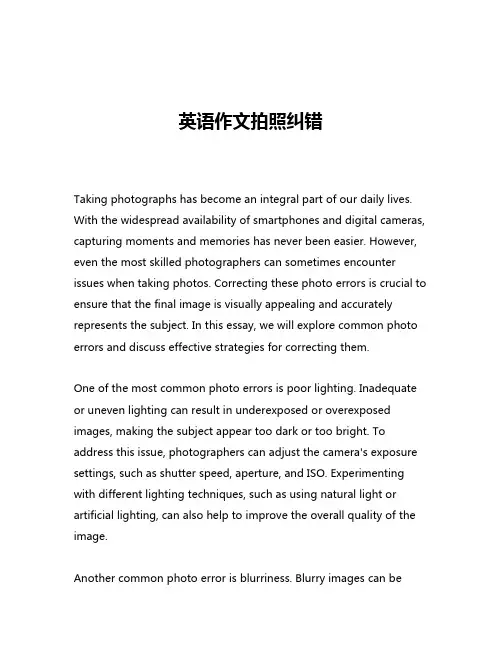
英语作文拍照纠错Taking photographs has become an integral part of our daily lives. With the widespread availability of smartphones and digital cameras, capturing moments and memories has never been easier. However, even the most skilled photographers can sometimes encounter issues when taking photos. Correcting these photo errors is crucial to ensure that the final image is visually appealing and accurately represents the subject. In this essay, we will explore common photo errors and discuss effective strategies for correcting them.One of the most common photo errors is poor lighting. Inadequate or uneven lighting can result in underexposed or overexposed images, making the subject appear too dark or too bright. To address this issue, photographers can adjust the camera's exposure settings, such as shutter speed, aperture, and ISO. Experimenting with different lighting techniques, such as using natural light or artificial lighting, can also help to improve the overall quality of the image.Another common photo error is blurriness. Blurry images can becaused by a variety of factors, including camera shake, subject movement, or incorrect focus. To correct blurriness, photographers can use a tripod or other stabilizing device to minimize camera shake. They can also experiment with different focus modes, such as manual or autofocus, to ensure that the subject is in sharp focus.Composition is another important aspect of photography, and poor composition can lead to a variety of photo errors. For example, anoff-center subject or cluttered background can detract from the overall impact of the image. To correct composition issues, photographers can use the rule of thirds, leading lines, or other compositional techniques to create a more visually appealing image.Color issues can also be a common photo error. Inaccurate or unnatural color can be caused by a variety of factors, such as incorrect white balance settings or poor lighting conditions. To correct color issues, photographers can use image editing software to adjust the color balance, saturation, and contrast of the image.In addition to these common photo errors, there are also a variety of other issues that can arise, such as lens distortion, noise, and artifacts. Lens distortion can cause the image to appear warped or distorted, while noise and artifacts can result in grainy or pixelated images. To address these issues, photographers can use specialized software or hardware, such as lens correction tools or noise reduction filters.Overall, correcting photo errors is an essential skill for any photographer, whether they are a professional or a hobbyist. By understanding the common causes of photo errors and the strategies for addressing them, photographers can create images that are visually stunning and accurately represent the subject. Whether it's adjusting lighting, improving focus, or enhancing color, the key to successful photo correction is experimentation, patience, and a commitment to continuous learning and improvement.。
英语作文拍照批改
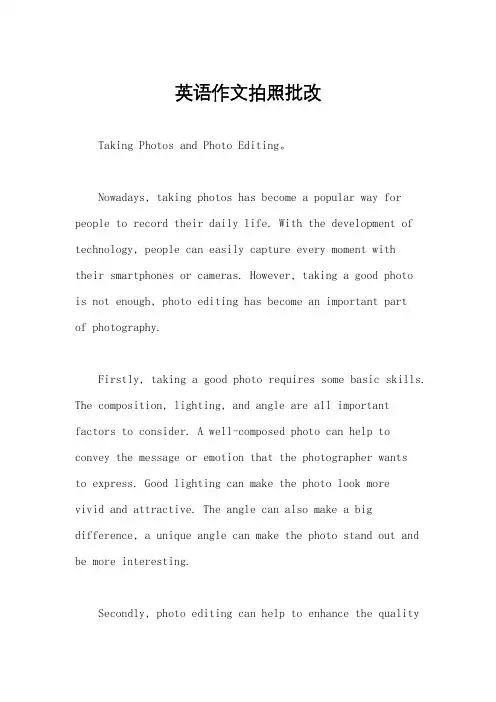
英语作文拍照批改Taking Photos and Photo Editing。
Nowadays, taking photos has become a popular way for people to record their daily life. With the development of technology, people can easily capture every moment withtheir smartphones or cameras. However, taking a good photois not enough, photo editing has become an important partof photography.Firstly, taking a good photo requires some basic skills. The composition, lighting, and angle are all important factors to consider. A well-composed photo can help to convey the message or emotion that the photographer wantsto express. Good lighting can make the photo look morevivid and attractive. The angle can also make a big difference, a unique angle can make the photo stand out and be more interesting.Secondly, photo editing can help to enhance the qualityof the photo. There are many photo editing software and apps available on the market, such as Adobe Photoshop, Lightroom, and VSCO. These tools can help to adjust the brightness, contrast, saturation, and other aspects of the photo. They can also add filters, stickers, and text to the photo to make it more creative and appealing.However, photo editing should be used with caution. Over-editing can make the photo look fake and unnatural. It is important to maintain the authenticity of the photo and not to misrepresent the reality. A good photo shouldreflect the true moment and emotion.In conclusion, taking photos and photo editing have become an important part of our daily life. With the right skills and tools, we can capture and enhance every moment of our life. However, we should also be aware of the potential risks of over-editing and maintain the authenticity of the photo.。
用人工智能完成作业被老师批评英语作文

用人工智能完成作业被老师批评英语作文My Big Mistake with the AI EssayI thought I was so smart. I found this really cool website that could write whole essays for you with just a few clicks. All you had to do was enter the topic, and boom - you got a brand new essay written by some artificial intelligence thingy. It was like having a super genius do all your homework! I couldn't believe how easy it was.I used it for the first time on the big essay Mrs. Thompson assigned on the causes of the American Revolution. I just typed in the topic and a few minutes later there was this five paragraph masterpiece all ready to go. I read through it and it actually sounded pretty good - way better than anything I could write on my own. The AI essay used all these fancy words and had lots of facts from the textbook woven in. It was perfect!I printed it out and turned it in the next day, feeling super proud of myself. I had outsmarted the whole system and didn't even have to study or do any real work. I was a genius hacker kid, beating the machine at its own game! I just knew Mrs. Thompson would be blown away by my revolutionary essay.A few days later, Mrs. Thompson handed back our graded essays. I could tell she was giving me a weird look as she passed mine back. I looked down and saw a huge red D- scrawled at the top. What?? How could my AI masterpiece only get a D-? This had to be a mistake.As I read through all of Mrs. Thompson's comments in the margins, I started to feel sick to my stomach. She had crossed out whole sections with her red pen, leaving comments like "not in your own words" and "clearly copied from source without citation." Busted.At the end, she had written: "Jonathan, I am very disappointed that you would turn in work that is not your own. You clearly used some sort of software or artificial intelligence to generate this essay instead of writing it yourself. This is unacceptable and essentially plagiarism. I expect much more from you. We will discuss this further after class."My heart sank into my stomach. I had gotten caughtred-handed by the plagiarism police. And worse, I had betrayed Mrs. Thompson's trust. She always said she could tell when students actually put effort into their work instead of taking shortcuts. Now I had proven her right in the worst way.After class, I had to endure the stern lecture from Mrs. Thompson about cheating, taking the easy way out, and the importance of doing your own work. She said using AI software is a form of academic dishonesty, no different than copying and pasting stuff from websites without giving credit. I hadn't ever really thought about it that way, but she was right. It wasn't my thinking or my writing at all - I had just let a computer do all the hard work for me.As punishment, Mrs. Thompson made me re-do the entire essay from scratch over the weekend, this time without any help from AI robots. It was torture! I had to read all the chapters in the textbook, take notes, make an outline, and write the whole thing out longhand. It took me two full days of hard work.When I finally turned in my human-written essay on Monday, it looked pathetic compared to the AI version. The writing was choppy, the arguments weren't as smooth, and I knew I had surely made some factual errors despite my best efforts. Part of me was tempted to quietly run it through the AI software one last time to touch it up. But after my plagiarism debacle, I knew I had to resist that urge. This was going to be my own work, flaws and all.To my surprise, Mrs. Thompson gave me a B- on the re-do essay. She said it was a huge improvement over the AI draft in terms of showing my own authentic thinking and writing ability. She reminded me that she can always tell when students put in genuine effort, even if the final product isn't perfect. What mattered more was that I did the hard work myself instead of taking an easy shortcut.I learned two very important lessons from this experience. One, using AI and other tech tools to cheat on assignments is really looked down upon - it's considered academically dishonest, just like any other form of plagiarism. Just because it's new technology doesn't make it any more acceptable in a teacher's eyes.Two, taking shortcuts rarely pays off in the long run. While letting AI software write my essay was easy and made my work seem deceptively good at first, it didn't allow me to actually learn the material or grow my skills. Doing it the old-fashioned way by writing it myself was definitely harder and more time-consuming. But ultimately, that's how I end up really internalizing and learning.From now on, I'll be doing all my own work, no matter how tedious or challenging it might seem. Using AI might help in theshort term, but relying on it too much is only cheating myself out of learning opportunities. Besides, I never want to get busted for plagiarism again - Mrs. Thompson's stern look is just too scary! I've learned my lesson about taking shortcuts. The hard work might be painful, but it's the only way to improve.。
小猿搜题作文让其批改
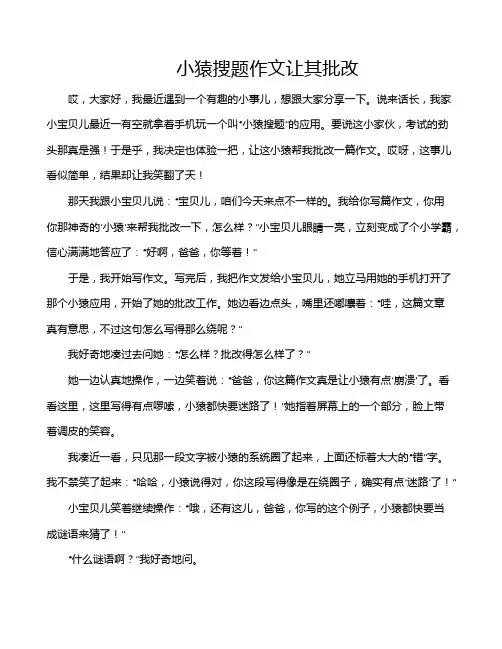
小猿搜题作文让其批改哎,大家好,我最近遇到一个有趣的小事儿,想跟大家分享一下。
说来话长,我家小宝贝儿最近一有空就拿着手机玩一个叫“小猿搜题”的应用。
要说这小家伙,考试的劲头那真是强!于是乎,我决定也体验一把,让这小猿帮我批改一篇作文。
哎呀,这事儿看似简单,结果却让我笑翻了天!那天我跟小宝贝儿说:“宝贝儿,咱们今天来点不一样的。
我给你写篇作文,你用你那神奇的‘小猿’来帮我批改一下,怎么样?”小宝贝儿眼睛一亮,立刻变成了个小学霸,信心满满地答应了:“好啊,爸爸,你等着!”于是,我开始写作文。
写完后,我把作文发给小宝贝儿,她立马用她的手机打开了那个小猿应用,开始了她的批改工作。
她边看边点头,嘴里还嘟囔着:“哇,这篇文章真有意思,不过这句怎么写得那么绕呢?”我好奇地凑过去问她:“怎么样?批改得怎么样了?”她一边认真地操作,一边笑着说:“爸爸,你这篇作文真是让小猿有点‘崩溃’了。
看看这里,这里写得有点啰嗦,小猿都快要迷路了!”她指着屏幕上的一个部分,脸上带着调皮的笑容。
我凑近一看,只见那一段文字被小猿的系统圈了起来,上面还标着大大的“错”字。
我不禁笑了起来:“哈哈,小猿说得对,你这段写得像是在绕圈子,确实有点‘迷路’了!”小宝贝儿笑着继续操作:“哦,还有这儿,爸爸,你写的这个例子,小猿都快要当成谜语来猜了!”“什么谜语啊?”我好奇地问。
“就是你提到的那个‘骑马打仗’,小猿以为你是在讲古代传说呢!”她一边说一边笑得差点从椅子上掉下来。
“哈哈,那确实有点儿意思。
”我忍不住也跟着笑了,“看来小猿也有它的趣味啊!”经过一番“批改”,我和小宝贝儿开心地讨论起作文的修改意见。
她一边用手指点着手机屏幕,一边和我讨论如何改进这篇文章。
有时候,她甚至直接用她那“绝妙”的小学语气模仿小猿的批注:“哎呀,爸爸,您这句写得好像在写诗啊,干脆把它改成打油诗吧!”我们俩笑得不可开交,小宝贝儿还一边调侃着:“爸爸,这篇作文如果参加小猿的作文比赛,可能要先过一关‘解谜’呢!”“哎呀,这可真是大开眼界啊!”我感叹道,“以后我得学会写得更明白一些,免得给小猿增加负担。
拍照批改纸质作文
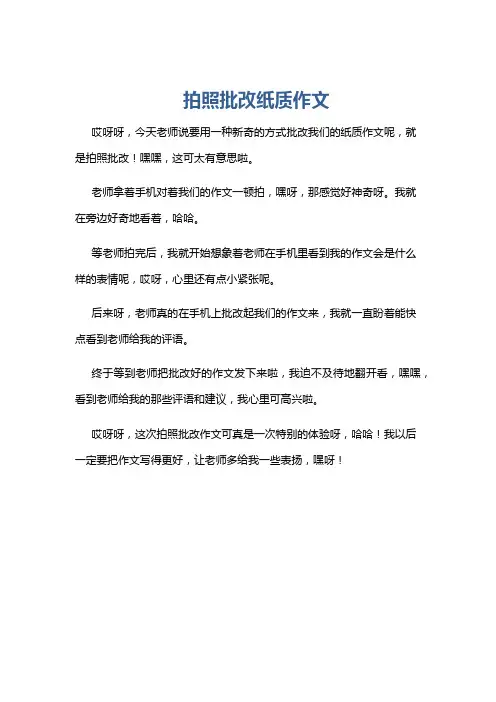
拍照批改纸质作文
哎呀呀,今天老师说要用一种新奇的方式批改我们的纸质作文呢,就是拍照批改!嘿嘿,这可太有意思啦。
老师拿着手机对着我们的作文一顿拍,嘿呀,那感觉好神奇呀。
我就在旁边好奇地看着,哈哈。
等老师拍完后,我就开始想象着老师在手机里看到我的作文会是什么样的表情呢,哎呀,心里还有点小紧张呢。
后来呀,老师真的在手机上批改起我们的作文来,我就一直盼着能快点看到老师给我的评语。
终于等到老师把批改好的作文发下来啦,我迫不及待地翻开看,嘿嘿,看到老师给我的那些评语和建议,我心里可高兴啦。
哎呀呀,这次拍照批改作文可真是一次特别的体验呀,哈哈!我以后一定要把作文写得更好,让老师多给我一些表扬,嘿呀!。
探讨小猿搜题APP作文批改功能
155FAXIAN JIAOYU 2018/05————————————————————————————摘要:近些年小猿搜题、百度作业帮等搜题软件已经在初高中生群体里得到了广泛应用,本文结合学生们常用的小猿搜题APP 使用经历,针对其最近推出的英语作文批改功能,通过查找资料总结分析了其背后的可能技术方案和实现方式,并通过尝试其对语文作文的批改问题,进一步思考该功能对语文作文的应用难点和未来展望,以此来拓展对APP 等计算机软件工作思路的了解。
关键词:小猿搜题;百度作业帮;A P P ;批改————————————————————————————如今,很多学习软件在校园流行,比如小猿搜题、百度作业帮等搜题软件就受到学生们热捧,尤其是小猿搜题APP,其只要通过对题目的拍照上传,就可以找到原题或类似题目的解答过程。
根据学生们的使用经历,其匹配成功率很高,而且能搜出各门科目题目,知识点涵盖范围广,又有详细的答案和解析,甚至有的还有视频讲解。
通过使用小猿搜题等APP学习软件,为学生的自主学习带来了巨大方便,当然这也需要结合学生的自我控制能力合理应用软件的搜题功能[1][2],才能真正有效地帮助其实现自主学习和提高学习效率。
近来,小猿搜题APP又新增了一项英语作文批改功能,笔者通过一段时间对该功能的使用,发现该功能适用性很强,有助于日常在家练习英语写作[3],同时该功能让原本老师们需要投入大量时间和精力进行人工批改作文的高强度人脑工作实现了网络化与智能化。
本文正是基于网络化与智能化的小猿搜题新增的英语作文在线修改功能,从图像识别、深度学习和人工智能等角度,分析其内在可能的工作过程,并以此为基础进一步思考后续可能的语文作文修改功能的实现展望,以此论文课题为背景了解当前最新计算机程序及相关算法技术,为学生后续进入大学学习相关专业奠定基础。
一、小猿搜题A P P 技术方案小猿搜题APP之所以受到学生的喜爱,其关键是使用起来很简单。
英语作文关于拍照搜题
英语作文关于拍照搜题Title: The Phenomenon of Searching for Answers through Photography。
In recent years, a peculiar trend has emerged among students, particularly in academic settings: using photography as a means to search for answers to questions. This phenomenon has garnered both curiosity and concern, as it raises questions about academic integrity, the role of technology in education, and the effectiveness oftraditional study methods. In this essay, we will delveinto the various aspects of this trend, examining its implications and potential consequences.First and foremost, it's essential to understand the mechanics of this practice. Students often utilize their smartphones or other devices equipped with cameras to capture questions or problem sets from textbooks, homework assignments, or exams. Subsequently, they upload these images to search engines or specialized platforms, such asquestion-and-answer websites or educational forums. Within moments, they receive solutions, explanations, or even completed assignments from a vast online community.One of the primary motivations behind this behavior is the desire for convenience and efficiency. In today's fast-paced world, where academic pressure is ever-present, students seek shortcuts to navigate the demands of their coursework. Photography offers a quick and effortless way to access information, bypassing the need for extensive research or critical thinking. Moreover, in instances where students feel overwhelmed or lack confidence in their abilities, obtaining immediate answers can alleviate anxiety and boost their self-esteem temporarily.However, this practice raises significant ethical concerns, particularly regarding academic integrity. Relying on external sources to provide answers undermines the principles of learning and intellectual growth. Education is not merely about obtaining correct solutions but also about the process of grappling with challenges, making mistakes, and learning from them. By bypassing thisprocess, students deprive themselves of valuable opportunities for growth and development.Moreover, the widespread availability of answers through photography contributes to a culture of academic dishonesty. When students perceive cheating as a viable option with minimal risk of detection, they are more likely to engage in unethical behavior. This can erode trustwithin educational institutions and devalue the credentials of those who achieve success through genuine effort and dedication.Another concern pertains to the quality of learning facilitated by this practice. While obtaining answers through photography may yield immediate results, it does little to foster deep understanding or critical thinking skills. True mastery of a subject requires active engagement, reflection, and application of knowledge in diverse contexts. Rote memorization of solutions obtained online does not facilitate the development of these essential skills and may ultimately hinder academic progress in the long term.Furthermore, the reliance on technology for academic purposes raises questions about the role of educators in guiding and supporting students' learning journeys. As technology continues to advance, educators must adapt their teaching methods to promote digital literacy, ethical conduct, and critical thinking skills. Rather than viewing technology as a threat to traditional education, educators should harness its potential to enhance learning experiences and empower students to become responsible, independent learners.In conclusion, the practice of searching for answers through photography reflects a broader shift in the way students approach learning in the digital age. While it offers apparent benefits in terms of convenience and accessibility, it also poses significant challenges to academic integrity, learning outcomes, and the role of educators. As we navigate this evolving landscape, it is imperative to strike a balance between leveraging technology for educational purposes and upholding the fundamental principles of integrity, inquiry, andintellectual growth. Only then can we ensure that education remains a meaningful and transformative experience for all learners.。
用人工智能完成作业被老师批评英语作文
The Dilemma of Using Artificial Intelligence in Homework: A Critical PerspectiveIn the modern era of technology, artificialintelligence (AI) has become a ubiquitous presence in our daily lives. Its application ranges from simple tasks like voice recognition to complex ones like autonomous driving. However, the recent trend of using AI in completing homework assignments has sparked a debate, particularly among educators and parents. This essay delves into the complexities surrounding this issue, focusing on a hypothetical scenario where a student is criticized bytheir teacher for relying on AI to complete their homework. Firstly, it is essential to acknowledge the convenience and efficiency that AI brings to homework completion. With the help of AI tools, students can quickly access information, analyze data, and even generate essays or mathematical solutions with minimal effort. This, in turn, frees up time that can be used for other pursuits, such as extracurricular activities or personal interests. However, this apparent benefit masks a deeper problem: the potentialdilution of intellectual effort and the loss of learning opportunities.Homework is not just about getting the right answers; it is a critical component of the learning process. It helps students consolidate and apply the knowledge they have gained in class, fostering critical thinking and problem-solving skills. When AI is used as a crutch, students miss out on these valuable learning experiences. They may obtain good grades on assignments, but they fail to develop the necessary skills and understanding that are essential for long-term academic success.Moreover, the use of AI in homework completion can lead to unethical behavior. Cheating, whether through plagiarism or the use of unauthorized assistance, undermines the integrity of the academic system. It gives students an unfair advantage over their peers and dilutes the value of the educational experience for everyone involved. Teachers, as guardians of academic standards, are rightfully outraged when they discover that students have relied on AI to complete their homework.However, it is also important to note that the blame should not solely be placed on the students. The education system and society at large play a significant role in shaping student behavior. In a culture that prioritizes grades and success over the process of learning, it is natural for students to seek shortcuts to achieve their goals. Additionally, the widespread availability and ease of access to AI tools make it tempting for students to use them for homework completion.To address this issue, a multifaceted approach is needed. Firstly, educators must emphasize the importance of the learning process over grades. They should encourage students to engage with their homework, ask questions, and seek help when needed. Secondly, schools and parents need to provide students with the necessary support and guidance to develop good study habits and ethical standards. This includes teaching them about the consequences of cheating and the importance of honest effort.Moreover, technological solutions can also be explored to detect and prevent the misuse of AI in homework completion. For instance, software that can detect patternsof plagiarism or unusual similarities between student assignments can be developed and implemented. Such tools, however, should be used as supplementary measures rather than replacements for human oversight and judgment.In conclusion, the use of artificial intelligence in homework completion presents a complex challenge for the modern education system. While AI offers convenience and efficiency, it also poses a threat to the integrity of the learning process. It is crucial for all stakeholders, including students, teachers, parents, and policymakers, to work together to strike a balance between leveraging the benefits of technology and preserving the essence of education. By fostering a culture that values intellectual effort and ethical behavior, we can ensure that the next generation of learners is equipped with the skills and knowledge they need to succeed in the increasingly complex world of tomorrow.**人工智能在作业完成中的困境:批判性视角**在现代科技时代,人工智能(AI)已经成为我们日常生活中的无处不在的存在。
英语作文智能批改,这功能吸引的人到底是谁呢?新
英语作文智能批改,这功能吸引的人到底是谁呢?猿辅导旗下的搜题应用小猿搜题最近测试上线的一项新功能,叫做“英语作文智能批改”。
它把人工智能技术用在了手写作文识别和英语作文的批改上。
目前这个功能还处在灰度测试中,我们最近去体验了下这个智能批改功能。
在我们的实际体验中,这个新功能在识别手写作文的速度很快。
在测试之前,我自己用钢笔手抄的作文片段。
在拍照完成后,它能在三秒左右的时间内就将手写的文字识别了出来。
现场测试视频片段不过对于部分被划去的文字的识别,它仍然存在遗漏或识别错误的地方。
比如文中第一段的第二个单词“ you ” ,由于文字比较模糊,在扫描过程中系统并没有识别出来。
文中第二段第一句中被划掉的单词“ this ”仍被识别显示了出来,在系统处理后的文章里出现了两次。
抄写的作文片段扫描作文后生成的作文页面在提交批改后,它能识别出一些简单的错误,比如在文中我错误的使用了“student”的单复数形式,它在文中准确的标注了出来。
标注错误的页面截图不过在语法搭配的识别上,它的准确率还不是很高。
在抄写的作文片段中,我故意留下了一些明显的错误搭配,比如在文中第一段第七行我将“more and more”错误得写成了“many and many”,但提交系统批改后,它并没有标注出这样的错误。
标注错误的页面截图目前小猿搜题主要针对国内 K12 的中小学教育市场,新出的英语智能批改系统的打分机制也是根据高考英语作文考试的大纲定的。
猿辅导研究部总监邓澍军告诉《好奇心日报()》,根据猿辅导此前在 K12 教育这个领域的数据积累,他们可以统计出一些中小学生在写作文时的常见错误分布情况,优化识别错误的算法。
包括常见错误搭配、Chinglish、词汇的错误使用等。
实际上智能批改已经不是一个新鲜事了,美国教育考试服务中心(ETS)在 1999 年首次开始采用智能批改系统,它也被应用到托福考试的评分过程中,并在 2008 年被引入到 GRE 作文的评分过程中,作为复查人工打分质量的辅助系统。
- 1、下载文档前请自行甄别文档内容的完整性,平台不提供额外的编辑、内容补充、找答案等附加服务。
- 2、"仅部分预览"的文档,不可在线预览部分如存在完整性等问题,可反馈申请退款(可完整预览的文档不适用该条件!)。
- 3、如文档侵犯您的权益,请联系客服反馈,我们会尽快为您处理(人工客服工作时间:9:00-18:30)。
(图片来源:Pixabay)
芥末堆 12 月 7 日讯,猿辅导公司今日发布“英语作文智能批改”产品,继拍照搜题之后,再次推出教育黑科技产品。
跟拍照搜题类似,在纸上写完英语作文之后,用手机拍照上传,系统可以自动识别手写单词,自动批改显示评分,并对语法、单词等错误进行批注。
猿辅导称,该产品的识别准确率达到 95%,并且支持全文手写离线识别。
拍照搜题之后,猿辅导推出拍照批改英语作文功能
作者:阿槑
2016-12-07 09:12
图:英语手写作文批改详情
据猿辅导方面介绍,这次发布的英语作文智能批改采用了由深度学习技术驱动的人工智能,识别和批改结果会更为准确。
目前 Google 已经将该技术应用在 AlphaGo 和 Google 翻译中。
猿辅导方面表示,该功能优先针对猿辅导寒假班的学员开放使用,并将于本月在小猿搜题内开放入口,预计明年年初对所有的老师和学生开放使用。
猿辅导公司的副总裁李鑫认为,在教、练、测三个环节中,练习和测评的效率更容易因为技术进步而带来革命性的发展,猿辅导一直在朝这个方向努力,用技术驱动行业变革。
在最近的媒体沟通会上,创始人李勇曾提到过这次发布的英语作文智能批改技术,并指出“背后有非常大的研发投入”。
用大数据和人工智能辅助英文写作,是国内外的教育创业公司都在尝试解决的问题,比如国外的英文智能写作批改工具 WriteLab 和 WriterKEY,以及国内的句酷批改网,都在为用户提供在线写作辅导服务。
版权声明:
1、本文是芥末堆网原创文章,转载可点击 芥末堆内容合作 查看相关规范,未经授权拒绝一切形式转载,违者必究;
2、芥末堆不接受通过公关费、车马费等任何形式发布失实文章,只呈现有价值的内容给读者。
